Parathas are one of the most popular and loved accompaniments in the Indian flatbread scene. And just like any other curry, lentil or rice-based dish with many variations to it, even the world of parathas has distinct recipes, from region to region. Just like this Parotta Recipe, which can be considered as the South Indian version of the North Indian Lachha Paratha, which simply means a layered paratha. It is a flaky, layered, unleavened flatbread, also known as the Malabar Paratha or Kerala Paratha. This recipe is also egg free, and sans yeast.

Table of Contents
About Parotta
In South Indian cuisine, a Parotta Recipe is what a regular paratha recipe in North Indian cuisine would be. The main differentiating factor between these two are that while parathas in North India are traditionally made with only whole wheat flour (atta), its counterpart in South India may be made with only all-purpose flour or a mix of both. But never, only atta.
This recipe of Malabar Paratha results in a soft, flaky and crispy layered flatbread. Making these is a time-consuming process, but worth investing your energy and efforts in making them.
In the end, once you bite into a morsel of this paratha with your favorite curry, you’ll know it was worth all the patience. It definitely makes for a treat, which you can enjoy once in a while.
To make Kerala Paratha at home, this recipe is the best procedure you can stick to and refer. It has no eggs and yeast, still gives delicious and drool-worthy parathas with tender, soft layers and crispy edges.
The Malabar Parotta can be served with any vegetable curry like veg kadai, veg handi, veg korma or lentil-based curries like dal makhani, paneer ghee roast, etc. Even the simple dal tastes absolutely divine with the Kerala Parotta.
Making of Malabar Paratha
A classic Malabar Paratha is made entirely with all-purpose flour or maida. Using all-purpose flour does give a great texture and flakiness to the paratha. To make this flatbread, the dough is rested many times during the preparation process.
However, you can even use a 1:1 ratio of whole wheat flour (atta) and all-purpose flour for this Parotta Recipe. Remember, with atta, the taste and texture of this paratha will be different. It will be more like the taste of the North Indian lachcha paratha.
Generally, the roadside eateries or restaurants use Dalda vanaspati (hydrogenated vegetable fat) to make Kerala Paratha. For health reasons, I don’t use it. I would suggest using a non-aromatic and flavorless oil to make these parathas.
You can even use butter or ghee. The more fat, the better the Parotta Recipe will be. However, I have used only 3 tablespoons oil (to coat the dough) for 2 cups of flour. You can increase the quantity to 4 to 5 tablespoons oil, if you prefer.
Generally in the hotels and restaurants, they stretch and flip the dough which won’t be easy for many home cooks. The method of making homemade Parotta is very easy and I have demonstrated in a step-by-step illustration, which will make the preparation easy to understand.
I have shown 2 techniques of getting the layers in the this tasty flat bread. Choose one which you are comfortable with.
Like I mentioned earlier, this recipe of Kerala Paratha does not use yeast. Warm water is added while kneading which does make a difference to the texture of these parottas.
This is also an egg-free way of making these fantastic South Indian style flatbreads at home, rather than buying the readymade ones from the market.
How to make Malabar Paratha
Make Dough
1. In a mixing bowl or a medium to large tray, take 2 cups (250 grams) all-purpose flour, 2 teaspoons sugar and ½ teaspoon salt or as required. Mix thoroughly with a spoon.

2. Next, add ½ cup + 3 tablespoons lukewarm water.
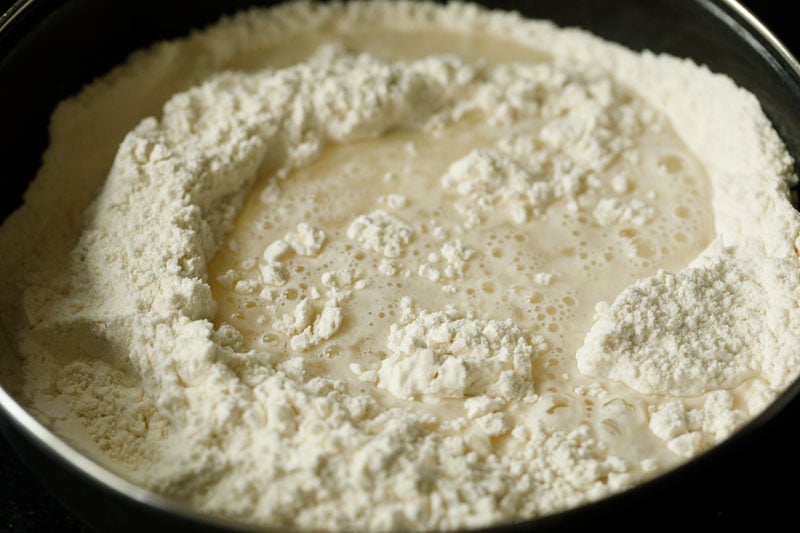
3. First mix the water with the flour, using a spoon.
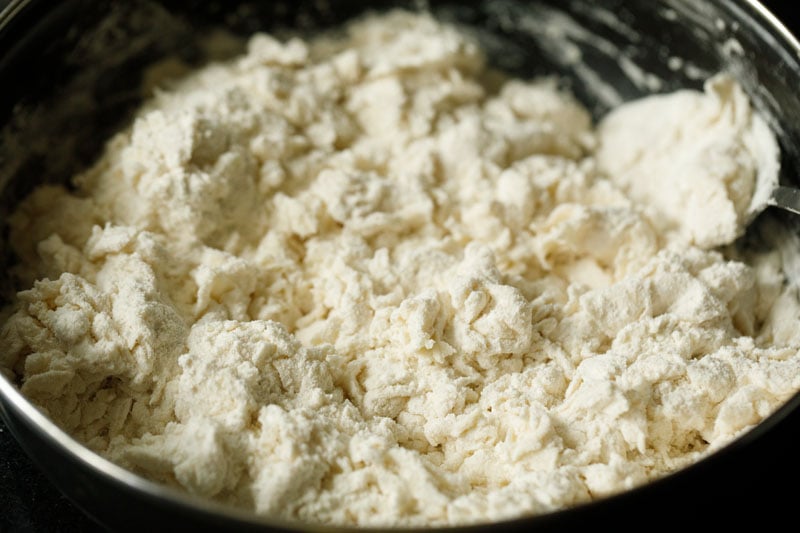
4. Then, start bringing together all the ingredients and begin to knead to a soft dough. At first, the dough will be sticky. But as you continue to knead, the water will be absorbed.
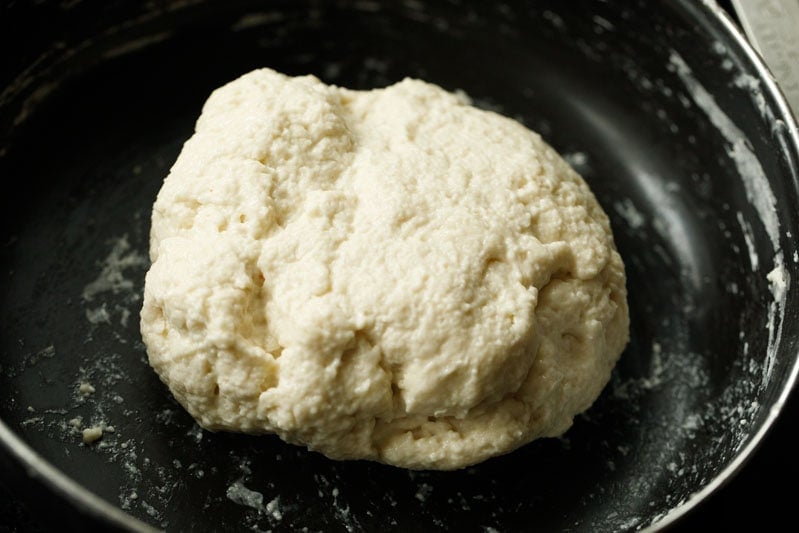
5. In the picture below, you can see that the water has been absorbed and a soft, supple and smooth dough is formed. Knead for about 12 to 15 minutes. The dough should have elasticity.

6. Cover with a moist cotton napkin or muslin cloth and allow it to rest for 45 minutes to one hour. If short of time, keep it for 30 minutes.

7. Portion the dough into 8 equal sized parts by first making a log of the dough and then cutting it in equal pieces.
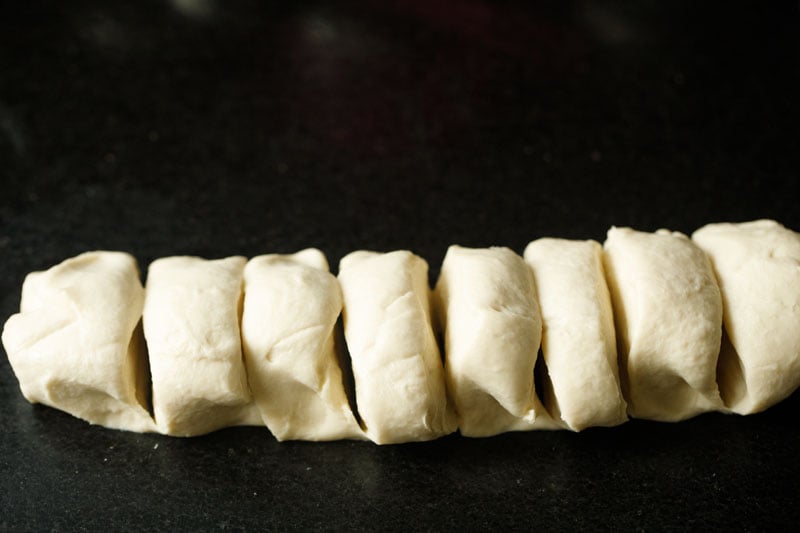
8. Roll each portioned dough between your palms and shape into round balls. Place the dough balls in the same bowl keeping some space between each of them.
Pour 3 tablespoons oil all over the dough balls.

9. Lift each dough ball and coat it evenly with the oil. Cover the bowl with a napkin or lid and allow it to rest for 20 to 30 minutes. You can keep for an hour too.
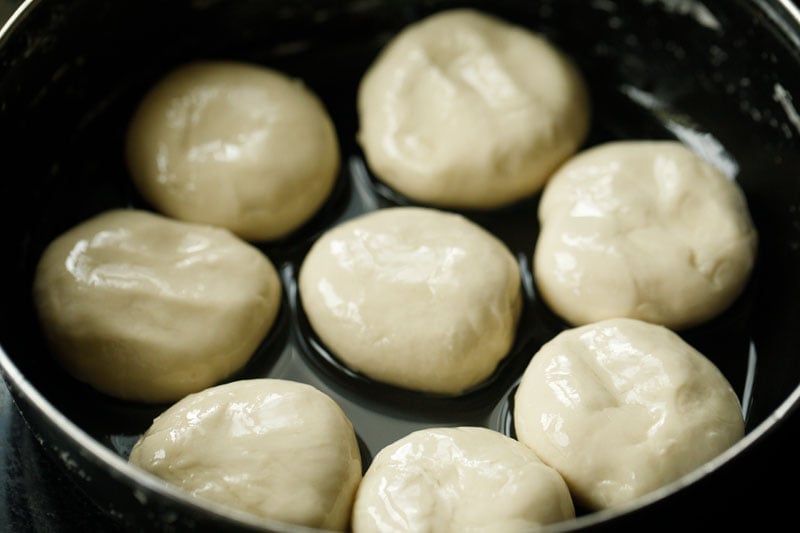
10. Remove oil-coated dough ball from the bowl, and place on a large board or on the kitchen countertop. You can use a large wooden board too, as the rolling surface.
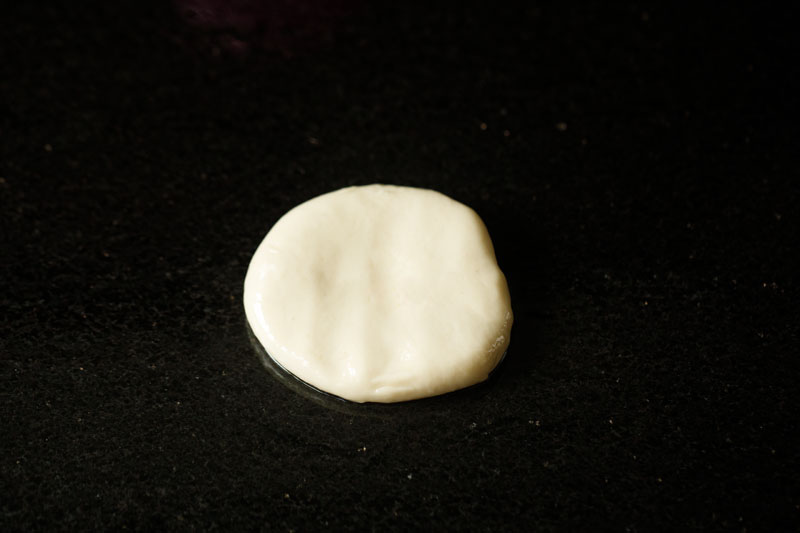
11. Begin to roll with a rolling pin. It can be tricky initially while rolling, as the dough will slide. But press and roll.

Make Layers – Method 1
12. Roll to about 12 inches disc or 12 by 9 inches rectangle, having a thin layer. I roll to about some height and then flatten the dough with my fingers. You can even flatten the dough with fingers, instead of rolling it from scratch.
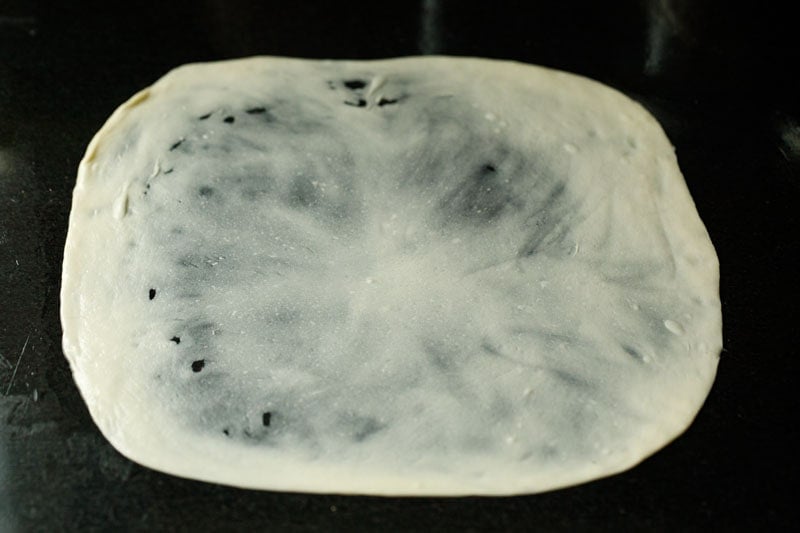
13. Cut 0.5 or 1 cm strips through out the entire dough, vertically.
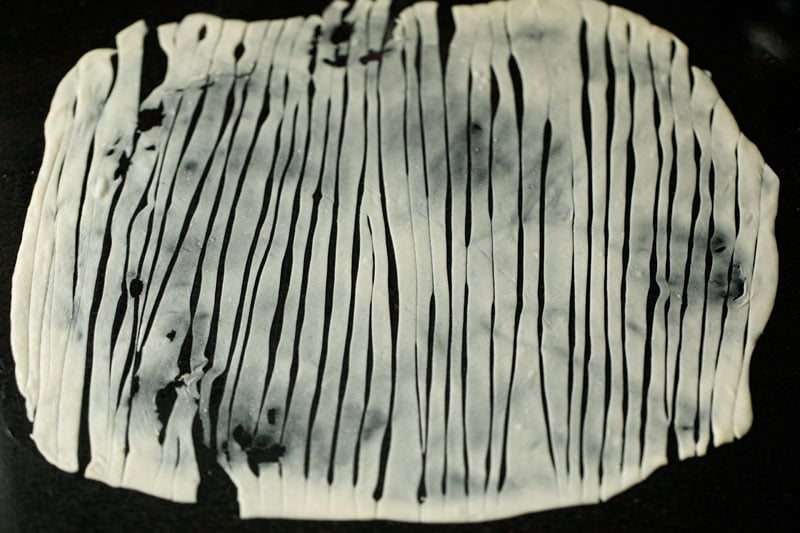
14. Roll and gently bring these cut strips together.
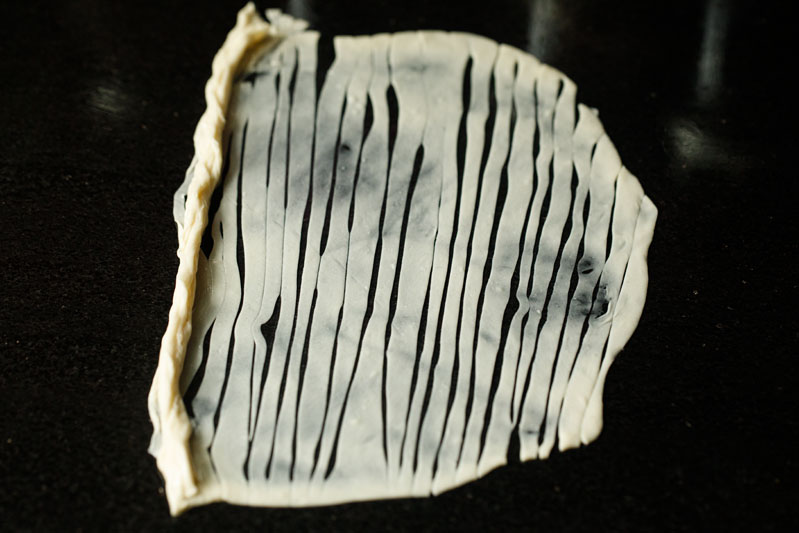
15. Place the long cut strips of dough collected together on the surface.
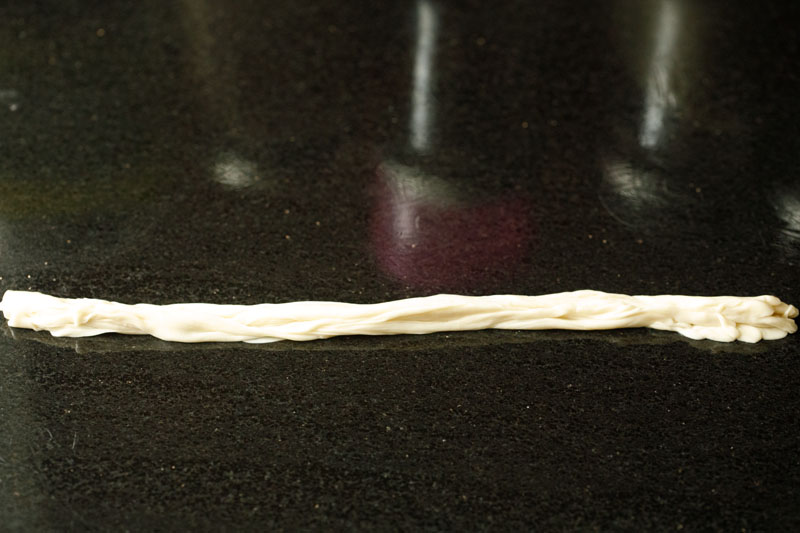
16. From one side, roll the dough and bring it together to make a spiral shape. Tuck in and press the end portion of the dough in the center.
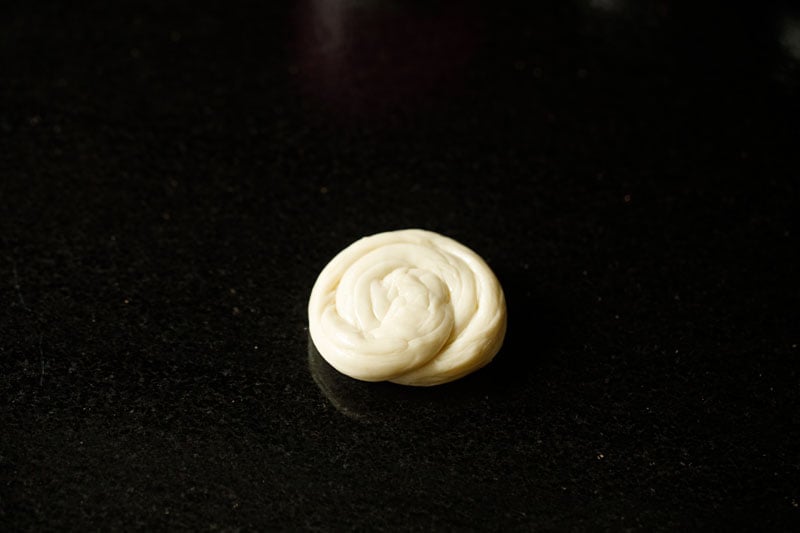
Make Layers – Method 2
17. Roll the flattened dough ball to a thin and almost transparent layer. Roll each ball as thinly as possible with a rolling pin.
You have to roll very thin. If the dough breaks or tears a bit, you can continue to roll.
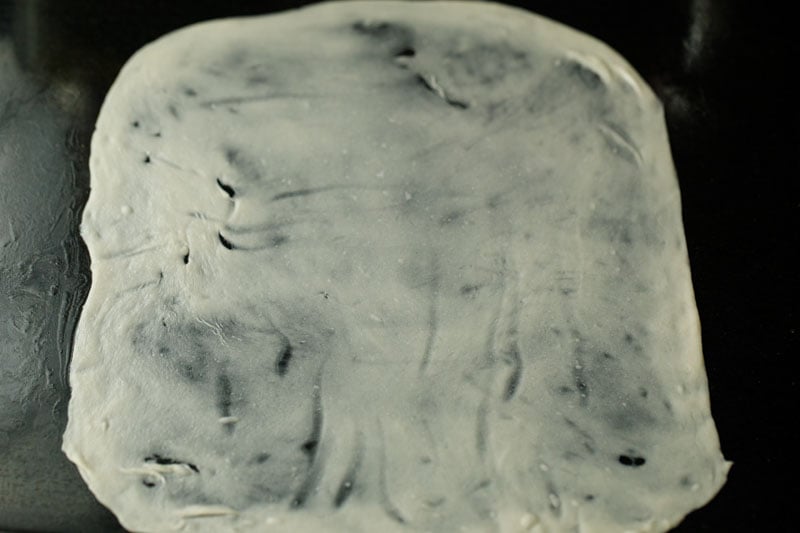
18. Hold the rolled dough from the top side and gently lift it up.
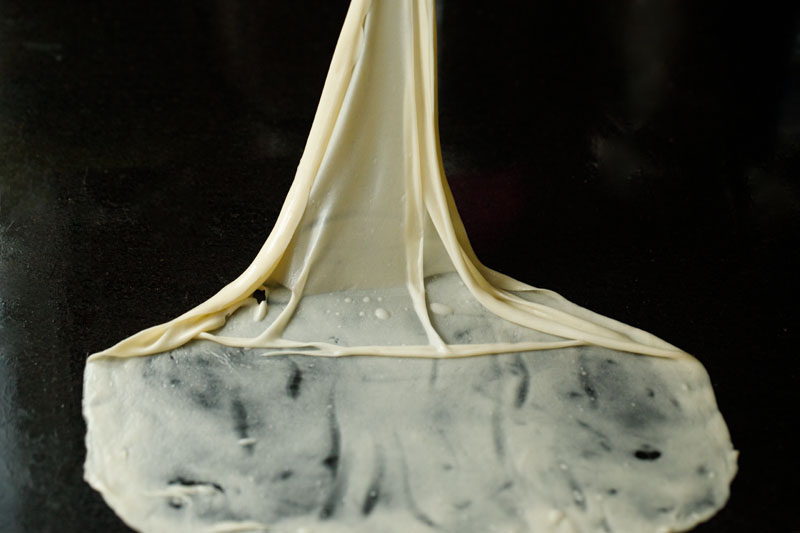
19. This will bring together the rolled dough into small pleats or folds.

20. Hold one end of the pleated dough, roll it like a spiral and press the last edge on to the center.

21. Prepare the layered dough balls whichever way you prefer. Place them in a bowl covered with lid or moist cotton cloth and keep aside to rest for 15 minutes.
Cover each layered dough ball as you shape them.

Make Kerala Parotta
22. Now, take one of the layered dough balls and place it on your rolling board. Roll to about 7 or 7.5 inches. It will shrink by a few inches.

23. Place on hot tawa or a flat cast iron skillet. Keep heat to medium high or high.
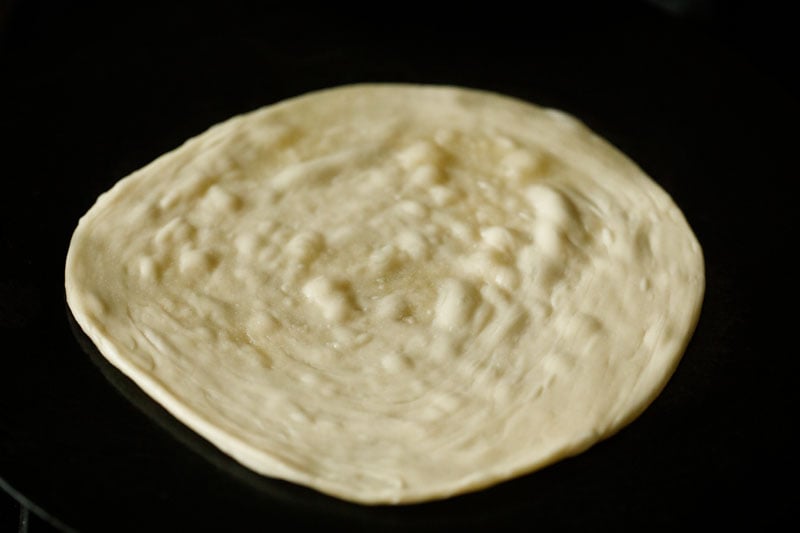
24. Cook one side for about 30 seconds or till lightly golden and crisp, and then flip.

25. Spread ½ teaspoon oil all over, on this partly cooked side.
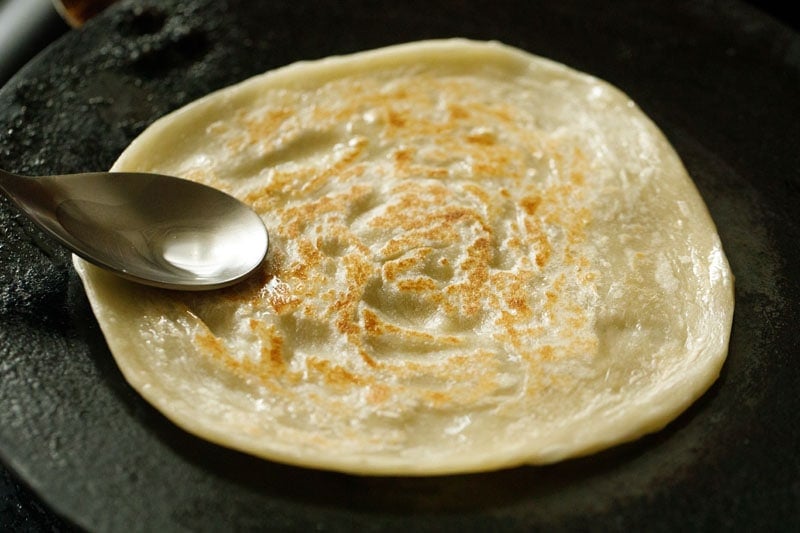
26. Cook second side for 30 seconds and flip again. Drizzle and spread ½ teaspoon oil all over.

27. Flip a couple of times and cook until golden and crisp. Press the edges with a spatula, so that they cook well. Remove from pan and keep aside on a plate.
This way roast and cook in batches the rest of the Parotta. If there is any oil left in the bowl (which was used to coat the dough balls), then use it to roast the last few batches of Parotta.

28. Once you have placed the Parotta on a plate, wait for half a minute. With your hands in a clapping motion squish the paratha, so that the layers are visible. Making the layers visible is optional.
You can place them in a roti basket and serve while still hot or warm. These are best eaten while still hot as they are soft, tender, slightly chewy and crispy. On cooling, they tend to become more chewy and less softer.

29. Serve Malabar Paratha hot or warm with any curry or lentil-based dish of your choice.
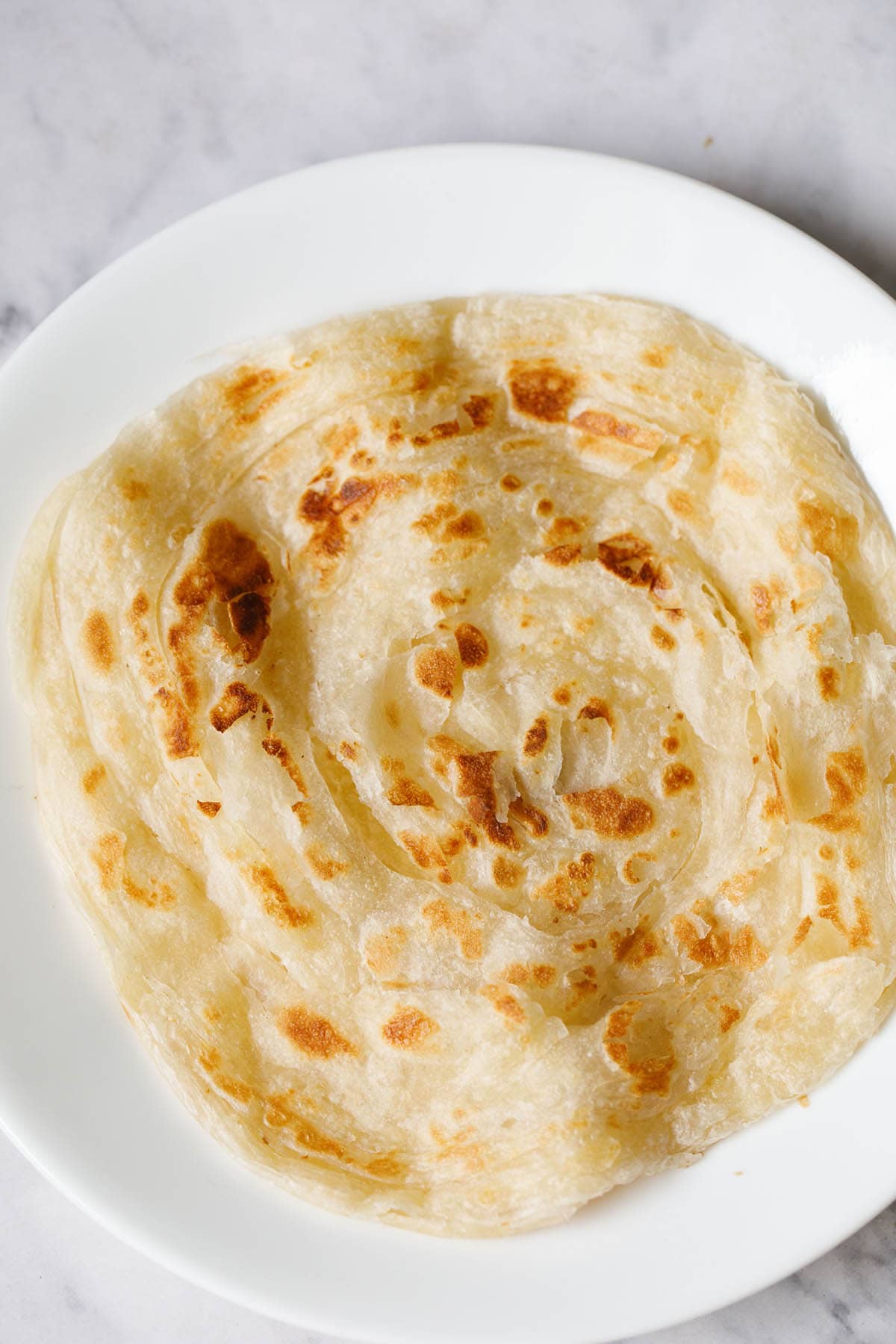
Malabar Paratha vs Lachcha Paratha
The South Indian style Parotta Recipe usually has all-purpose flour (maida) as the main ingredient, whereas Lachha Paratha from North India is primarily made with whole wheat flour (atta). Hence, there is a huge difference in the textures of both these flatbreads.
All-purpose flour creates fluffy, soft, smooth layers with a crispy outer in the Malabar Paratha, while whole wheat flour, makes for firmer textures in the lachcha paratha.
Having said that, parottas can be made with an equal mix of whole wheat flour and all-purpose flour too. I do recommend to use organic unbleached flour, if possible.
I really have good memories of having crisp and flaky Kerala Paratha during our vacations in South India. We would just have them plain, dunked in tea or with a flavorful coconut-based vegetable korma or curry.
The outer crisp and flaky edges giving way to the inner soft layers, yum is the word to describe it.
Even with lachha parathas, I have some fond memories as some of my family members are from North India. Whenever we would travel to this part of the Indian subcontinent, we’ve been trying out really authentic versions of this famous North Indian layered paratha.
It is not less than its South Indian counterpart, for sure. And if you ask me to choose my favorite, I won’t be able to!
Expert Tips
- Flours: It is best to make this Kerala Paratha with only all-purpose flour. However, you can also make with a mix of whole wheat flour and all-purpose flour, or entirely whole wheat flour too. But with only whole wheat flour, it will be more like the North Indian lachcha paratha.
- Method to make layers: To make this Kerala Paratha, you can choose any of the methods as shown above, depending on what suits you. Personally, I find the holding the dough and creating folds easier, than cutting the rolling dough. You can choose to make the layers visible in the roasted paratha, by squishing the parathas in a clapping motion. However, this is optional.
- Fats: You can use a mix of softened ghee/butter and oil for this Parotta Recipe. Oil helps in making the dough soft, which in return makes the layers soft and tender when cooked.
- Roasting: Do not over do the roasting, as it can make the parottas chewy and denser. Also keep the heat to medium-high or high. Roasting on low heat may make the parotta get a dry and hard texture.
- Time: Making this Parotta Recipe involves a lot of prep time. So, do consider this factor.
More Indian Bread Recipes To Try!
North Indian Food Recipes
Indian Breads
Indian Breads
Indian Breads
Please be sure to rate the recipe in the recipe card or leave a comment below if you have made it. For more vegetarian inspirations, Sign Up for my emails or follow me on Instagram, Youtube, Facebook, Pinterest or Twitter.

Malabar Paratha | Kerala Paratha | Parotta Recipe
Ingredients
- 2 cups all-purpose flour (maida) – 250 grams
- ½ cup + 3 tablespoons water – lukewarm, or add as required
- 2 teaspoons sugar
- ½ teaspoon salt or add as required
- 3 tablespoons oil for coating dough balls
- 2.5 to 3 tablespoons oil or as needed for roasting
Instructions
Making parotta dough
- In a mixing bowl take the all-purpose flour, sugar and salt. Mix the dry ingredients thoroughly with a spoon.
- Add lukewarm water in portions and begin to knead the dough.
- Knead the dough for 12 to 15 minutes or until soft, smooth, supple and elastic adding water as needed.
- Cover with a moist cotton napkin and set aside to rest for 45 minutes to 1 hour. You can also let the dough rest for 30 minutes if short of time.
- Next portion dough into 8 equal sized parts by first making a log of the dough and then cutting it into equal pieces.
- Roll each portioned dough between your palms and shape to round balls.
- Place the dough falls in the same bowl keeping some space between each of them.
- Pour 3 tablespoons oil all over the dough balls. Lift each dough ball and coat it evenly with the oil.
- Cover with a napkin or lid and rest the oil coated dough balls for 20 to 30 minutes. You could let them rest for an hour also.
Making Layers – Method 1
- With a rolling pin, roll to about 12 inches circle or 12 by 9 inches rectangle having a thin layer. If you have the skill, you can even flatten the dough with fingers instead of rolling it with a rolling pin.
- Cut the rolled layer of dough to 0.5 or 1 cm strips vertically.
- Bring the cut strips gently together in one lot. Place these long cut strips of dough collected together on the rolling surface.
- Roll and gather the dough to make a spiral shape. Tuck in and press the end portion of the dough in the center.
Making Layers – Method 2
- With a rolling pin, roll the flattened dough ball to a thin and almost transparent layer. Roll each ball as thinly as possible.
- Lift the rolled dough upwards and gently hold it up. This will bring together the rolled dough into small pleats or folds.
- Hold one end of the pleated dough, roll it like a spiral and press the last edge on to the center.
Making Malabar Paratha
- Prepare the layered dough balls whichever way you prefer. Place them in a bowl covered with a lid or moist cotton cloth.
- Set aside to rest for 15 minutes. Cover each layered dough ball as you shape and roll them so that they do not dry out.
- Heat tawa or a flat cast iron skillet on medium-high to high heat.
- Take one of the layered dough ball. Roll to about 7 or 7.5 inches using a rolling pin. The rolled dough will shrink by a few inches after you roll it.
- Place on the hot tawa or skillet. Keep heat to medium high or high.
- Cook one side until lightly golden and crisp for about 30 seconds and then flip with a spatula or tongs.
- Spread ½ teaspoon oil all over on this partly cooked side.
- Cook second side until for 30 seconds and flip again. Drizzle and spread ½ teaspoon oil all over.
- Flip once or twice and cook until golden and crisp.
- Press the edges with spatula so that they cook well. Remove from pan and set aside in a plate.
- You will see the layers easily and they will be browned.
- This way roast and cook in batches the rest of the parotta. If there is any oil leftover in the bowl (that was used in coating the dough balls) then use it roast the last few batches of parotta.
- Once you have placed the parotta on a plate, wait for half a minute. With your hands in a clapping motion squish the Malabar Paratha, holding them between your palms so that the layers come up on the surface. Making the layers visible is optional.
- You can also place them in a roti basket and serve them while still hot or warm. These are best eaten while still hot as they are soft, tender, slightly chewy and crispy. On cooling they tend to become more chewy and less softer.
- Serve the Parotta with your favorite curry or gravies or lentils.
Notes
- Oil makes the dough soft and makes for tender layers when the parotta is cooked. If you prefer, you can use a mix of oil with softened butter or ghee.
- As a variation, opt to make the Malabar Paratha with an equal mix of whole wheat flour and all-purpose flour.
- Do remember to knead the dough really well. It should be soft, smooth, supple and have an elasticity when rolled.
- The layered dough balls can be prepped ahead and refrigerated for a day. Remember to keep them covered air-tight so that they do not become dry on the surface.
- Easily scale the recipe to make a small batch of the parotta or make for more servings.
Nutrition Info (Approximate Values)
This Malabar Paratha post from the blog archives first published in August 2013 has been updated and republished on December 2022.


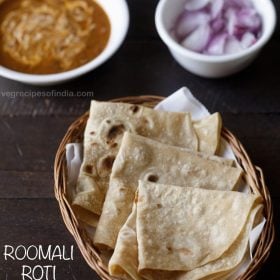

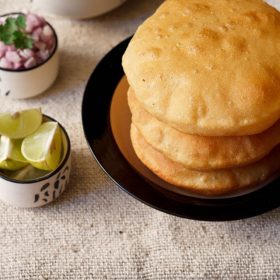
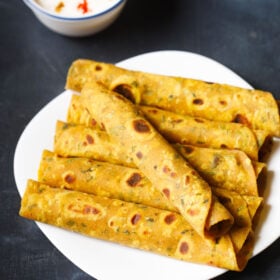









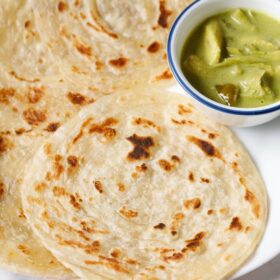
Very useful to know all about the Veg recipes. Dassana’s effort truly a right tool to keep our body healthy and get ready for the soulful journey.
Thank you Dassana for all these incredible gifts ( dishes)
Thanks a lot Nirmal and most welcome.
Easy to follow recipe. Simple, healthy and delicious!
Oh my god, I just love it! So easy and soooo tasty!
With your step by step instructions it so easy and joyful to make!
Thank you so much ☺️
Thank you Maya.
Made these crispy parottas today. Used a stand mixer to knead which made for a nice soft dough. Followed the first rolling method. Viola had the most amazing parottas. Reminded of the parotta we would have in Kerala during our vacation.
Thanks Sana. Glad to know you liked the parotta recipe.
Nice recipe. Easy method of making kerala paratha. All your recipes are easy and are very helpful for beginners. Thank you.
pleased to know seema 🙂 you like our blog recipes thankyou for your kind and encouraging words. you are welcome.